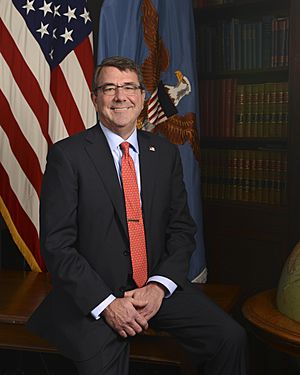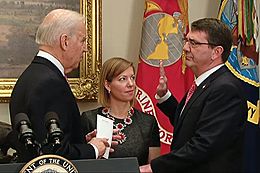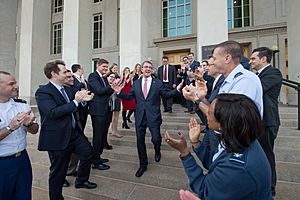Ash Carter facts for kids
Quick facts for kids
Ash Carter
|
|
|---|---|
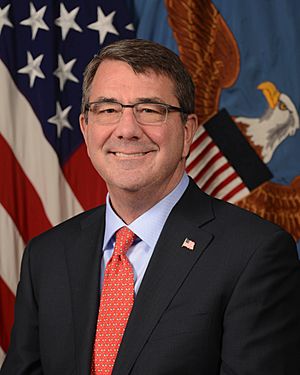
Official portrait, 2015
|
|
| 25th United States Secretary of Defense | |
| In office February 17, 2015 – January 20, 2017 |
|
| President | Barack Obama |
| Deputy | Robert O. Work |
| Preceded by | Chuck Hagel |
| Succeeded by | Jim Mattis |
| 31st United States Deputy Secretary of Defense | |
| In office October 6, 2011 – December 4, 2013 |
|
| President | Barack Obama |
| Secretary |
|
| Preceded by | William J. Lynn III |
| Succeeded by | Christine Fox (acting) |
| Under Secretary of Defense for Acquisition, Technology and Logistics | |
| In office April 27, 2009 – October 5, 2011 |
|
| President | Barack Obama |
| Preceded by | John J. Young Jr. |
| Succeeded by | Frank Kendall III |
| Assistant Secretary of Defense for Global Strategic Affairs | |
| In office June 30, 1993 – September 14, 1996 |
|
| President | Bill Clinton |
| Preceded by | Stephen Hadley |
| Succeeded by | Jack Dyer Crouch II (2001) |
| Personal details | |
| Born |
Ashton Baldwin Carter
September 24, 1954 Philadelphia, Pennsylvania, U.S. |
| Died | October 24, 2022 (aged 68) Boston, Massachusetts, U.S. |
| Political party | Democratic |
| Spouses |
|
| Relations | Cynthia DeFelice (sister) |
| Children | 2 |
| Education | |
| Signature |  |
| Scientific career | |
| Thesis | Hard processes in perturbative QCD (1979) |
| Doctoral advisor | Christopher Llewellyn Smith |
Ashton Baldwin Carter (born September 24, 1954 – died October 24, 2022) was an important American government official. He served as the 25th United States Secretary of Defense, which is like being the main leader for the U.S. military. He held this role from February 2015 to January 2017. After his time in government, he worked at Harvard University.
Carter started his career as a physicist, someone who studies how the universe works. Later, he decided to work in public policy, which means helping to create government rules and plans. He joined Harvard University in 1984.
During President Bill Clinton's time, from 1993 to 1996, Carter was an Assistant Secretary of Defense. He helped make decisions about nuclear weapons and worked with countries that used to be part of the Soviet Union.
Later, during President Barack Obama's time, he became the United States Deputy Secretary of Defense. This role is like being the chief operating officer for the entire Department of Defense. In 2015, he became the Secretary of Defense. During his time, he made big changes. He allowed women to serve in all military jobs, even in combat roles. He also made it possible for transgender people to serve openly in the military.
Ash Carter received many awards for his work in national security. He also wrote 11 books and over 100 articles about science, technology, and national security.
Contents
- Ash Carter's Early Life and Family
- Ash Carter's Education and Learning
- Ash Carter's Academic Career
- Ash Carter's Work at the Department of Defense
- Ash Carter as Secretary of Defense
- Other Important Roles and Work
- Ash Carter's Views and Beliefs
- Ash Carter's Personal Life
- Awards and Honors
- Ash Carter's Books
- Images for kids
- See also
Ash Carter's Early Life and Family
Ashton Baldwin Carter was born on September 24, 1954, in Philadelphia, Pennsylvania. His father, William Stanley Carter Jr., was a World War II veteran and a doctor. His mother, Anne Baldwin Carter, was an English teacher. Ash had three siblings, including the children's book author Cynthia DeFelice.
He grew up in Abington, Pennsylvania. When he was 11, he had his first job at a car wash.
Ash Carter's Education and Learning
Carter went to Highland Elementary School and Abington Senior High School. In high school, he was active in sports like wrestling and lacrosse. He was also the president of the Honor Society.
He studied at the University of Edinburgh in Scotland for a short time. In 1976, he graduated from Yale University with two degrees: one in physics and one in medieval history. He graduated with very high honors. He also worked on quark research at famous science labs like Fermilab and Brookhaven National Laboratory.
Carter then became a Rhodes Scholar, which is a special scholarship to study at the University of Oxford in England. He earned his PhD in theoretical physics in 1979. He studied how tiny particles behave.
After Oxford, he continued his research at Rockefeller University. He also worked at the MIT Center for International Studies. There, he wrote a report saying that the "Strategic Defense Initiative" (also known as "Star Wars") plan would not protect the U.S. from a nuclear attack.
Ash Carter's Academic Career
Carter taught at Harvard University for many years. He started as an assistant professor in 1984. He became a full professor and helped lead the Belfer Center for Science and International Affairs. This center focuses on how science and international relations connect.
At Harvard, he led the International and Global Affairs faculty. He also co-directed a project called the Preventive Defense Project. This project worked on ways to prevent big new threats to the United States.
Ash Carter's Work at the Department of Defense
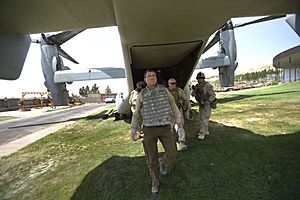
From 1993 to 1996, Carter was an assistant secretary of defense. He was in charge of strategic affairs. This included dealing with the danger of weapons of mass destruction around the world. He also worked on policies for nuclear weapons. He helped with the Agreed Framework in 1994, which aimed to stop North Korea's nuclear program. He also helped remove all nuclear weapons from Ukraine, Kazakhstan, and Belarus.
From 2009 to 2011, Carter was the Under Secretary of Defense for Acquisition, Technology, and Logistics. In this role, he was responsible for how the Department of Defense bought new equipment and technology. He helped get thousands of special vehicles called MRAPs (Mine-Resistant Ambush Protected) for troops. He also started a program called "Better Buying Power" to help the military buy things smarter and save money.
From 2011 to 2013, Carter became the Deputy Secretary of Defense. This was like being the chief operating officer for the entire department. He managed the huge budget and oversaw three million civilian and military personnel. He helped guide the department's plans and budget during tough economic times.
Ash Carter as Secretary of Defense
President Barack Obama chose Ash Carter to be the 25th United States Secretary of Defense in December 2014. The Senate approved him in February 2015.
During his nomination hearing, Carter said he wanted to increase military help to Ukraine. He also said the U.S. must work to defeat ISIS forces in Iraq and Syria.
In May 2015, Carter warned China to stop building artificial islands in the South China Sea. In October 2015, he spoke out against Russian air strikes in Syria.
In January 2016, Carter made a big decision. He opened all military jobs to women, meaning women could now serve in any role, including combat. In June 2016, he announced that transgender people could also join and serve openly in the military.
Other Important Roles and Work
Carter was involved in many other important groups and projects. He was the chairman of the Editorial Board for a magazine called International Security. He also worked at the Office of Technology Assessment and Rockefeller University.
In 1997, Carter and former CIA Director John M. Deutch studied the risk of catastrophic terrorism. They wrote an article about it in 1998. He also advised on creating the United States Department of Homeland Security.
Carter was a long-time member of the Defense Science Board and the Defense Policy Board. These groups give advice to the Secretary of Defense. He also advised the Secretary of State and testified often before Congress.
Outside of government, Carter advised investment firms on technology and defense. He was also a consultant for companies like Goldman Sachs. From 2020 until his death, he served on the board of directors for General Electric.
He was also a member of many important organizations, including the Council on Foreign Relations and the American Physical Society. He was elected a fellow of the American Academy of Arts and Sciences. In 2021, he joined the President's Council of Advisors on Science and Technology (PCAST).
Ash Carter's Views and Beliefs
Views on Iran
Carter had strong views on Iran. In 2006, he wrote a report suggesting that force might be needed to stop Iran from getting nuclear weapons. He also supported talking with Iran and finding ways to manage a nuclear-armed Iran.
Support for Military Actions
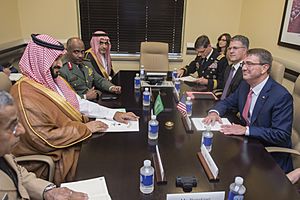
Carter supported the 2003 invasion of Iraq. He also suggested that "preventative" invasions might be needed for North Korea and Iran. When tensions grew in Ukraine, Carter considered placing missiles in Europe to stop Russian weapons.
Ash Carter's Personal Life
Ash Carter was married to Stephanie DeLeeuw Carter. He was previously married to Clayton Spencer, and they had two children, Ava and Will.
Carter passed away from a heart attack at his home in Boston on October 24, 2022. He was 68 years old.
Awards and Honors
Carter received the Ten Outstanding Young Americans award in 1987. He was given the Department of Defense Medal for Distinguished Public Service five times, which is the highest award for a civilian in the DOD. He also received the Chairman of the Joint Chiefs of Staff Joint Distinguished Civilian Service Award and the Defense Intelligence Medal for his work in intelligence.
Ash Carter's Books
Ash Carter wrote or co-wrote 11 books, along with many articles and studies:
- MX Missile Basing (1981)
- Ballistic Missile Defense (1984)
- Directed Energy Missile Defense in Space (1984)
- Managing Nuclear Operations (1987)
- Soviet Nuclear Fission: Control of the Nuclear Arsenal in a Disintegrating Soviet Union (1991)
- Beyond Spinoff: Military and Commercial Technologies in a Changing World (1992)
- A New Concept of Cooperative Security (1992)
- Cooperative Denuclearization: From Pledges to Deeds (1993)
- Preventive Defense: A New Security Strategy for America (1997)
- Keeping the Edge: Managing Defense for the Future (2007)
- Inside the Five-Sided Box: Lessons from a Lifetime of Leadership in the Pentagon (2019)
Images for kids
-
Carter, William Perry, and former secretary of state George P. Shultz in 2012.
-
Carter meeting Israeli prime minister Benjamin Netanyahu in Israel, July 21, 2015.
See also
 In Spanish: Ashton Carter para niños
In Spanish: Ashton Carter para niños



